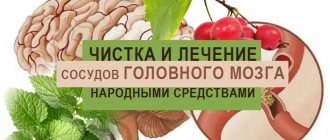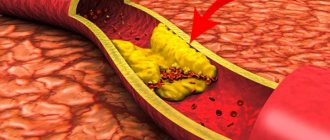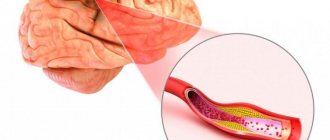Around the so-called "Cleansing of blood vessels"
A whole industry and many myths have developed.
However, our blood vessels are not pipes; even theoretically, cleaning them to get rid of cholesterol plaques or calcium deposits is not at all so simple. Does “vascular cleaning” even exist, or is it a misconception and a marketing ploy? We talked with our expert - cardiologist, functional diagnostics doctor, candidate of medical sciences Anna Nikolaevna Kotelnikova
, to learn more about the prevention and treatment of atherosclerosis.
On the eve of the New Year and the festive feast, be attentive to your diet and take care of yourself!
Vessel cleaning - what is it?
In official medical terminology, there is no such thing as “cleaning blood vessels” - this is everyday slang that is misleading and creates confusion. Unfortunately, it is impossible to remove cholesterol plaques that have already formed and clean a clogged vessel like a water pipe using a magic cleaning agent or “nanothreads”. An entire industry has already formed around the cleaning of blood vessels, however, the drugs and procedures that are offered to solve the problem do not have proven clinical effectiveness, the same applies to traditional methods. Restoring the functional state of the vascular endothelium is much more serious than detox, which is only appropriate for the primary prevention of vascular blockage. With atherosclerosis, when the vessels are narrowed by less than 50%, there is a risk of blood clots, heart attack or stroke
, the doctor prescribes drug therapy (
statins
,
calcium antagonists
and other drugs). However, they do not remove plaques, but compact them, thus increasing the lumen of the vessel. Therefore, it is extremely important to adhere to simple recommendations for the prevention of atherosclerosis.
In colloquial language, “cleaning” is also called cardiac surgery to expand a dangerously narrowed vessel - angioplasty, bypass surgery, stenting
. Their methods differ, but the essence is approximately the same: a catheter is inserted into the vessel, and the damaged, pathologically narrowed area is straightened and strengthened from the inside using implants - special rings, springs or tubes. The need for such operations arises if an atherosclerotic plaque closes the lumen of the vessel (artery) by more than 50%. When the blood supply is so disrupted, cells and organs are not supplied with oxygen and nutrients, and a person’s life can hang by a thread. It happens that a vessel or artery is blocked by a blood clot - a person suddenly feels very tired to the point of loss of consciousness, rapid heartbeat, suspicious pain (headaches, in the area of the heart), suffocates, and the skin turns pale. Such conditions are considered acute, and as a “cleansing” procedure, thrombolysis with special drugs is used on an outpatient basis. After stenting, bypass surgery or angioplasty, blood supply is restored, but it is necessary to take special medications and be observed by a cardiologist.
How to independently diagnose whether there are varicose veins or not? If a vein is visible, is it varicose veins?
Varicose veins are diagnosed either by symptoms, i.e. according to subjective sensations: nagging, severe pain, heaviness in the legs, swelling, discomfort; or by objective: dilated veins, the presence of one or more nodes. In any case, such symptoms should not be ignored, but it is better to get advice and then monitor the development of the pathology. If the veins are clearly visible on the body, this does not indicate varicose veins. There are such people, they are also called “geographical map”, in whom the vessels are very close to the surface, and the skin is very thin. Varicose veins can only be differentiated using ultrasound, or rather duplex scanning. This diagnostic method shows the operation of the valves that lift blood up through the veins against the force of gravity of the earth. And if the valve does not work, it means that the vein is affected by varicose veins.
Why do blood vessels become clogged?
Vessels become blocked for various reasons, but most often this occurs due to cholesterol plaques and the deposition of calcium salts (calcinosis). The mechanism for the formation of such blockages is more complex than it seems, and it lies behind our everyday habits - even the most harmless at first glance. For example, when we eat highly salty foods
, blood thickening and fluid retention occur - blood pressure increases.
When we experience stress
, the hormones adrenaline and norepinephrine are produced - key vessels narrow, and pressure increases because the amount of blood that the heart needs to push remains unchanged. In a normal healthy state, the vessels cope with such loads, but over time, serious problems can begin, and this is not only hypertension.
Diagnostic measures
The presence of a specific pathology, as well as its exact cause, can only be determined during a face-to-face consultation with a specialist. During it, the doctor will ask several general questions regarding lifestyle and chronic diseases, study the medical history in detail, conduct some functional tests, and clarify the presence of similar pathologies in close relatives. As part of the examination, the doctor will ask you about the frequency and intensity of your symptoms, monitor your clinical picture, and identify the suspected etiology of the disease.
If suspicions are partially confirmed, you will be prescribed simple tests:
Rheovasography (RVG) is a non-invasive functional method for assessing pulse blood supply to the extremities, as well as the tone, elasticity and patency of peripheral vessels using a specific device;
Measurement of the brachial-ankle index - a one-time determination of the level of blood pressure in the area of the shoulders and ankles (normally it is the same);
Biochemical blood test (cholesterol content), and other tests to detect cardiac dysfunction.
For a more in-depth study of the course of the disease, the following measures are taken:
1. Duplex scanning of arteries and veins;
2. Angiography using a contrast agent;
3. Magnetic resonance angiography;
4. Multislice computed tomography of the lower extremities;
5. Functional tests.
Causes of atherosclerosis
The fact is that due to systematic additional loads, microdamages can form on the walls of the arteries. Damaged tissues swell. Cells that respond to inflammation (for example, white blood cells) accumulate around the damage, and fat and cholesterol that float in the blood also cling to them - a cholesterol plaque is formed. It is no longer possible to get rid of it using completely non-invasive methods. At the same time, the walls of the vessels become coarser and thinner - this pathological condition is called atherosclerosis, which in turn can lead to coronary artery disease and causes the need for “cleansing of blood vessels”.
Thus, it is important not only to eat right, but also to maintain the functional state of the cardiovascular system.
Treatment of thin and fragile vessel walls with folk remedies
Any therapy, including traditional ones, requires the approval of a doctor. If the specialist believes that herbal treatment in combination with traditional therapy will improve your condition, proceed with the matter.
Freshly brewed loose leaf tea is good for strengthening thin blood vessels. It’s good if you drink it with lemon, it will enrich the drink with vitamin C. Chokeberry and rose hips are very rich in this vitamin. Rowan berries can be eaten just like that, raw. Or you can squeeze juice out of them and make compote. An infusion is prepared from rose hips: the berries are poured with boiling water and allowed to brew. Drink half a glass twice a day.
Herbal decoctions also help with fragility of blood vessels. The root of the field steelweed, walnut leaves, peppermint, berries and black currant leaves are good. They should be used in consultation with a doctor.
Good and bad cholesterol
There are several types of lipoproteins (cholesterols). Low-density lipoproteins
(LDL)
are considered bad , but there is also a good one -
high-density lipoproteins (HDL)
. The latter works almost as an antagonist of bad cholesterol, allows you to control lipid metabolism - helps in transporting substances and detoxifying the body from bad cholesterol. Below we will tell you how to maintain the correct LDL-HDL balance and what else you need to pay attention to.
Prevention of vascular atherosclerosis
Avoid foods with high cholesterol levels
Limit animal products with high cholesterol content in your diet: lard, fatty meat, offal, fatty dairy products and whole milk, egg yolk. This does not mean that you need to completely abandon animal proteins and fats. The menu should be dominated by vegetables and fruits, complex carbohydrates and cereal fibers, especially fiber. It is important to control sugar levels and not overindulge in sweets and starchy foods - it is better to replace chocolate bars and snacks with dried fruit sweets and nuts, and your body will thank you.
The method of preparing dishes also plays an important role
- before you put meat or scrambled eggs in oil on a hot sizzling frying pan, think about whether it might be better to steam it? It is forbidden? Okay, but for frying it is better to use vegetable oils, such as olive oil.
Citrus fruits also fight fat and cholesterol
, in particular the substance pectin, isolated from
grapefruit
.
Pectin
is a soluble fiber that is found only in citrus fruits themselves, but not in juice.
We get cholesterol from 2 main sources. Most of the cholesterol (about 1 g per day) is produced by our liver - and this is enough.
We get the other part directly from food.
There is another life hack: pay attention to labels in the store, try to avoid products labeled “partially hydrogenated fats”
.
Play sports - train your heart and blood vessels
WHO recommends at least 150 minutes of physical activity per week.
During training, the body is detoxified, and the blood vessels are strengthened - this is also a kind of “cleansing of blood vessels.”
Even after undergoing stenting/bypass surgery, you can play sports and even run a marathon. However, such patients first need to take medications for quite a long time and be observed by a doctor. Patients with cardiovascular diseases need to calculate the permissible level of physical activity and select its optimal option. bicycle ergometry is for.
, which allows you to take stress tests on a device similar to a bicycle with special sensors.
Check your cholesterol levels
Once a year, it is recommended to take a special blood test - a lipid profile - to see if there is an increase in the level of total cholesterol or its fractions. In this way, it is possible to understand in a timely manner whether everything is fine with lipid metabolism or whether drug correction is necessary.
Primary prevention of atherosclerosis and blockage of blood vessels also involves visiting a therapist or cardiologist once a year, even if there are no complaints.
Treat periodontal disease, control sugar levels and body weight
Everything in our body is interconnected. It has been proven that patients with periodontal disease, like patients with diabetes and overweight, are more predisposed to atherosclerosis.
In 2021, the study “Metabolic syndrome and periodontal disease: An overview for physicians”
(Srivastava MC, Verma PK) with important and very interesting conclusions. In patients with poor teeth and a predisposition to atherosclerosis, intensive periodontal therapy after 2 months showed a significant reduction in the levels of c-reactive protein, interleukin-6 and low-density lipoprotein cholesterol.
Measure your blood pressure
The absolute norm for blood pressure in an adult is considered to be 120/80 mmHg, but depending on the individual characteristics of the body, deviations are possible.
Monitor calcium levels and nutrient balance in the body
It is recommended to take additional Omega-3
- the body does not synthesize these beneficial fatty acids on its own - and you need to eat a lot of seafood and season salads only with flaxseed oil to make up for this deficiency. Omega 3 polyunsaturated fatty acids are the basis not only for strong and clean blood vessels, but even a building material for the brain. The average adult is recommended to consume 250 mg of Omega 3 per day throughout his life.
Vitamin K3
prevents calcium from being washed out of the bones and deposited on the walls of blood vessels. Most K₂ is found in fermentation products: cheese and fermented milk products.
Vitamin D and C, coenzyme Q10 are also extremely important for blood vessels
Stay hydrated, give up bad habits and get enough sleep
Drink clean filtered water throughout the day - about 1.5 liters.
The permissible amount of alcohol per day, which does not harm your heart and blood vessels, is 1 glass of good quality red wine; it is better to completely give up smoking.
You can get the maximum benefit from sleep if you sleep for 7-8 hours in a comfortable environment, without light or gadgets, and wake up only with or without an alarm clock.
Women and men over 40 years old
Patients in the older age group should be especially attentive to the state of the cardiovascular system and the primary prevention of atherosclerosis. Statistically, men are more susceptible to this disease, and hormones play an important role in this.
During the reproductive period, a woman’s ovaries produce sexual estrogens, which regulate the content of fats in the blood and prevent the deposition of cholesterol on the walls of blood vessels, that is, they protect the woman’s body from atherosclerosis.
During menopause, ovarian function declines, they stop producing estrogen, and its content in the blood drops sharply. This leads to the fact that cardiovascular diseases in women after menopause appear 5 times more often than before it.
Therefore, at this age it is recommended to consult a gynecologist-endocrinologist.
, who may prescribe menopausal hormone therapy if necessary. MHT can not only improve the quality of life and prolong it, but also preserve beauty from the inside.
Doctors at the Cardiology Center of the Pirogov Clinic provide qualified assistance to patients in the treatment of atherosclerosis, preventive diagnostics, as well as recovery after stenting, bypass surgery, and a heart attack.
You can make an appointment with a cardiologist or directly with Dr. Anna Nikolaevna Kotelnikova through our website.
What are the modern effective methods? How safe are they? When is surgery necessary?
The most popular and effective methods for eliminating varicose veins in Russia and other countries are laser coagulation and radiofrequency obliteration. Compared to classical operations, the safety of these techniques is much higher. For laser treatment, for example, there are now no restrictions on age or stage of the disease. The question of the need for intervention is decided very individually, based on the dynamics of the disease and the patient’s readiness. Sign up for a diagnosis and consultation with a phlebologist by phone.








